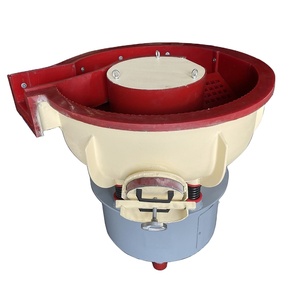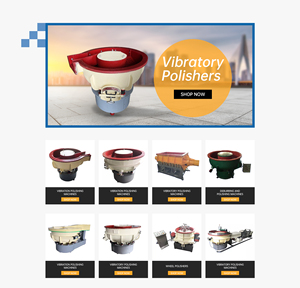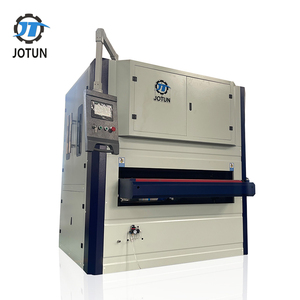
All categories
Featured selections
Trade Assurance
Buyer Central
Help Center
Get the app
Become a supplier

(3946 products available)













A vibratory deburring machine is a metal finishing machine that removes burrs by using vibration, which can be dangerous and fatal to the flesh and body. Some common types and their workings are as follows:
Mass Finishing Vibratory Machine:
This machine uses a metal tub to hold pieces of metal with cuts and the rounded stones on the metal while vibrating. The stones rub the metal in an abrasive manner, and all burrs can be easily removed this way. The stones can be made of ceramic, plastic, or any other suitable form of matter.
Separation Vibratory Machine:
This machine uses a specific type of vibratory screen to separate the parts after deburring is done. It is usually a cone or circular-shaped screen that separates the rounded parts of metal after finishing from those that are still in the deburring zone. The separation happens because of the centrifugal movement of the screen, which throws the parts of the metal in a circular manner. Usually, the parts that are not finished are thrown back in the vibratory machine for further work.
Spiral Bowl Finishing Machine:
This is a mass production deburring machine, which vibrates in a circular bowl-shaped container. The parts are then moved in a spiral manner, with the help of vibration, to come to the discharge point. In this way, continuous operation can be achieved. The machine is inherently safer because smaller parts do not get stuck and can enter and exit the machine smoothly.
Magnetic Drive Finishing Machines:
These machines move the media, and parts of metal are moved in a random manner by exciting the parts with magnetic forces. This random movement ensures uniform and smooth deburring of the parts of metal. Moreover, the process can be done hurriedly. One of the main advantages of these machines is that they can finish a provided job in a fraction of the time taken by others, i.e., 30% to 80% faster.
Frequencies and Speeds:
Machines operate at varied frequency ranges to achieve different speeds for the polishing rate. The common frequency is 60Hz, equivalent to 3,600 revolutions per minute for a 6-cylinder motor. A motor with 1,800 rpm may suffice for light work.
Horsepower:
Horsepower varies from a quarter to half a unit for smaller machines, and it determines the work amount completed and running costs.
Volume and Weight:
Typically measured in gallons, the machine's volume relates to the weight and load of parts it can process.
Side Walls:
Higher sides allow the media to separate parts easily and lower sides facilitate the reverse separation process. Usually, the side walls are between 24 and 36 inches.
Separators:
Tapered separators are cone-shaped devices that separate rounded parts from the media as they exit the vibrating machine. Non-tapered variants are used for irregularly shaped parts.
Regularly monitor and adjust the tension to avoid premature belt wear or damage to the vibrating motor and drive components. Periodically inspect and adjust the media separation devices for correct positioning while considering the frequency and speed adjustments. They can separate properly and not cause excessive vibratory machine media or separator wear.
Drain and clean the basins monthly. Develop a machine cleaning schedule based on type and amount of deburring media. Regularly examine belts, washings, and parts for wear, damage, and deterioration. Look for misalignments, loose components, and abnormal vibrations.
In industrial facilities, maintain the washings and parts of the machines at their optimum to prevent external contamination and reduce the frequency of machine cleaning. Do the job safely, productively, and effectively by using the right tools to service the machines and eliminating any health and safety hazards relating to machine servicing and maintenance.
Vibratory deburring machines are used to deburr delicate, complex, and intricate parts, especially metal ones. However, they can also be used to remove fines and scratches and burnish the surface of workpieces made out of different materials. These include those made out of hard plastics, ceramic, and even rubber.
Vibratory machines are the preferred method of deburring for many industries, especially those that work with small to medium-sized metal parts. This is because the machine can automatically and quickly remove burrs, even on complicated geometries, without affecting or damaging the integrity of the part in question.
Swimming Pool Industry:
The swimming pool industry makes heavy use of plastic vibratory deburring machines. Most parts of a swimming pool are made out of plastic, especially if the pool is an above-ground pool or a child's pool. Plastic vibratory deburring machines are used to remove rough edges from plastic pool parts like connectors, flanges, and any other parts that need to be smooth so that they can connect well to other parts and won't have any sharp edges that can cause injuries.
Automotive Industry:
Manufacturers in the automotive industry work with various materials, from alloys to metals like stainless steel. Vibratory deburring machines can remove unwanted burrs from factory-made automotive parts like engine parts, gear parts, brake parts, transmission parts, and lightweight auto body parts, to name a few. The parts often have complicated geometries and usually require quick mass deburring methods. The automotive industry often prefers vibratory machines over manual deburring because the machines can handle the job with greater efficiency and speed, especially if there are many parts to debur.
Jewelry-Making Industry:
The jewelry-making industry works with gold, silver, and other metal and alloy materials. These include copper and brass, which are also used often in the-making of jewelry, including chains, gold bracelets, bangles, and any other jewelry items. The industry often employs vibratory deburring machines to smooth out the jewelry item's edges. This makes the jewelry more comfortable to wear and handle, especially pieces with intricate designs and delicate points.
Firearms Industry:
The firearms industry uses vibratory deburring machines to remove the rough edges of firearms parts, including gears and weapon bodies. Stainless steel is commonly used for.. firearm weapons due to its rust-resilient properties and strength. A vibratory deburring machine quickly and efficiently removes the gun's rough edges, especially if it has a more complex and delicate design. The machine can also prepare the surface of the firearm weapon to allow a better and more even coating.
Both small and large-scale manufacturing units can benefit from the affordability, durability, noise level, productivity, bail size, and efficiency of vibratory deburring machines. When deciding what kind of machine to purchase or sell,it's critical to identify the target population by industry and overall purchase capacity.
As mentioned, vibratory machines are more affordable than their centrifugal counterparts, which means that almost all production lines can effectively use them for deburring and polishing. Industries with high production lines seeking to improve efficiency may easily opt for machines with larger bails, greater load capacities, and longer processing times.
Vibratory machines can be left to operate autonomously for several hours, even days, while continuing to produce polished items. This autonomy may offer some energy savings, as workers tend to be more deburring items with manual machines. The 'hands-off' feature of vibratory machines makes them more efficient as production lines do not have to reduce output to deal with unpolished items.
Identifying the machine's noise level could determine whether or not it is worth purchasing, as some workplaces have a very high ambient noise level. Wearing ear protection may be preferable to consider the actual noise level of the machine. Some workplaces may be so concerned about their overall noise levels that even the subtle sound of a vibratory machine may be enough to warrant its exclusion from the production line.
Domestic buyers may be more concerned about the price because vibratory machines are more economically feasible than investing in more expensive, efficient, and faster centrifugal machines. Before placing a bulk order, buyers should be sure to meet all of the machine's specifications. Including the essential features that all production lines would appreciate in these machines is crucial to a successful sale.
Identify the machine's overall energy efficiency to help narrow down the choices. The energy efficiency, along with the processing time, load capacity, and autonomy, can help calculate the overall cost of production per polished item.
Q: What size workpieces can a vibratory deburring machine handle?
A: The machine can handle smaller parts that can be bulk-loaded. Typical workpiece sizes are under 6 inches, but parts up to 24 inches can be deburred if they are small enough to allow the burr to be removed by the media in the machine.
Q: How much dirt or other contaminates must be removed from the part before it goes into the vibratory deburring machine?
A: Because cleaning chemicals can be very costly, only large amounts of dirt, such as sand or coal, should be removed from the part before deburring. For example, a coal-power plant might only need to remove the scale of coal inside the processing equipment. Usually, processing plants and factories will send parts for deburring after roughly 80% of the dirt has been removed.
Q: Is it better to use a cylindrical or triangulated media filing in a vibratory deburring machine?
A: Triangular or pyramid media provides better deburring of internal features and angles. Therefore, a combination of media shapes is often used to achieve the uniform deburring of complex part geometries.
Q: What is the standard processing time for vibratory deburring machines?
A: About 30 minutes to 4 hours, depending on the workpiece material, the size of the workpiece, and the media used.
Q: What are the possible media types used in a vibratory deburring machine?
A: The media can be made from plastic, ceramic, corn cob, walnut shell, steel, or rubber. Other materials may be available depending on the supplier.